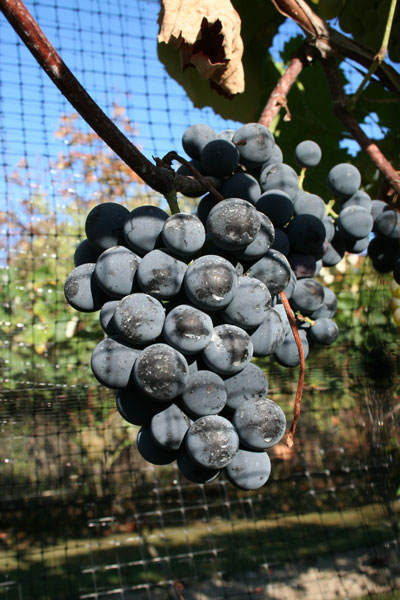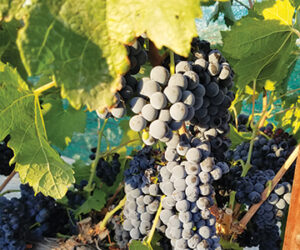
Just about everyone, wine consumer and abstainer alike, knows the name Concord. It may have been the first sip of wine to pass the lips of many beginner wine drinkers. Over 300,000 tons of Concord grapes are destined each year for the consumer as table grapes or unfermented grape juice found in the juice aisle or frozen juice section of the supermarket.
Concord is also grown extensively as a backyard garden grape. Many families look forward to picking these grapes each year to make homemade Concord pies, grape jam, jelly and estate-made wine.
Concord grapes are a dark bluish-purplish color. The juice can be a dark purple or reddish color, depending on the duration that it is in contact with the skins. It has been described as having a grapey, musky, may blossom, soda-popish aroma and flavor. Some even go so far as to describe the aroma as foxy.
Known as a Native American grape, Concord is a member of the Vitis labrusca grape family. It is also referred to as a slip-skin grape, the fox grape or skunk grape. Why the name, fox or skunk grape? Lots of tales (or tails — sorry, but the urge to make this pun is irresistible) surround the origin of these names.
Some say it is because these animals used the wild grapes as a source of food and were often spotted near the vines. Some sources refer to the Concord aroma as smelling like the fur of a fox or skunk. Personally, I hope I am never close enough to a skunk to experience the smell of its fur or any odor emitted from the animal!
It is interesting to note that slip-skin grapes are known to grow in every state in the United States except Alaska. A slip-skin is described as the colored, outer portion of the grape known as the skin that separates readily from the inner portion, which consists of the pulp and seeds. Many slip-skin grape varieties contain two to four seeds.
Known for its ability to withstand harsh winter conditions, Concord is a vigorous producing vine that can live for many years. To many winemakers in cold climate areas, this is a consistently successful equation for a steady source of grapes for wine.
After seven years of hybrid research of native vines, Ephraim Wales Bull of Concord, Massachusetts (near Boston) released the Concord grape vine for sale in 1854. He named the grape in honor of the town. It is said that Concord was the first native grape to be cross-pollinated with European stock to produce hybrid vines.
Concord is widely grown in the northeastern part of the United States. It is also grown in California and Oregon. An estimated 50% of the grapes harvested in the western New York and Lake Erie region are Concord. Much of that crop is destined to be Welch’s grape juice, jelly and jam. Concord is also grown throughout Pennsylvania, Ohio and parts of Canada and Brazil for similar purpose. Grapeseed oil, a byproduct of the grape, is extracted and sold, often in health food stores, for its beneficial anti-oxidative properties and bracing tart, woody flavor.
Concord grapes are high in flavor, pectin, acid level and usually low in sugar. To the winemaker, this means that amelioration (dilution by water to reduce acidity) is an option without sacrificing flavor. Pectic enzyme should also be added to the grapes or juice and chaptalization (sugar addition) is almost always necessary to make an 11–12% alcohol wine.
Winemakers have learned to craft many styles of well-made wine from this bountiful, flavorful grape — from a deep, dark purplish full-bodied wine, to a red medium-bodied wine, to a pinkish blush light-bodied wine.
Concord Tips and Techniques:
- Fermenting on the skins will, most often, yield a darker, more saturated color as compared to a medium red or blush pink color when fermented with juice.
- Cool fermentation temperatures (65–68 ºF or 18–20 ºC) will minimize strong foxy flavors.
- Ferment using yeasts such as: Lalvin 71B-1122, Red Star Côte des Blancs or Champagne.
- Pectic enzyme usage is important to prevent a pectic haze. Use per manufacturer’s instructions. You may wish to try using Klerzyme 201, a specifically formulated pectic enzyme for Vitis labrusca grapes.
- Ripe Concord grapes are a very dark purple. Under ripe grapes will give light color and flavor.
- Amelioration (the addition of water to the must) is the preferred method of reducing acidity. A general rule of thumb for ameliorating Concord: 1 part water to 4 parts juice. (Example: 1 gallon (3.8 L) of water is added to 4 gallons (15.2 L) Concord juice. Remember to add 2 pounds (908 grams) to 2.25 pounds (1021 grams) of sugar to the water added to produce approximately 11.5-percent alcohol by volume.)
- Other Acid Reducing Methods — Calcium carbonate or potassium bicarbonate can be used if further acid reduction is needed.
- Malolactic fermentation usually is not considered as a method of reducing acid since a fresh and fruity style wine is preferred.
- Oak additions are rare. If the wine is stored in an oak barrel, it is usually an older barrel with neutral flavor contribution.
- Blending Concord wine with other finished wines merits a word of caution. A small amount (5% by volume) can make a huge flavor impact. Make sure you start with a small test batch of wine to be blended and record your additions in your record book. Taste test with each Concord addition.
- Residual sugar — A goal of each winemaker is to enhance the flavor and to balance the acid levels in order to produce a pleasing wine. Concord wines usually have high acid levels that can be balanced with sugar to please the palate. Many native wines are bottled with 2–8% residual sugar levels and 0.7–0.8% acid levels. These semi-sweet and sweet wines are very popular. If lower acid levels are achieved (0.6%), dry and semi-dry (0–2 residual sugar levels are options. Taste testing is mandatory when sugar additions are made to the finished wine.
Concord Conclusion:
Commercially, Concord is best known as a very sweet table wine and a fortified dessert wine. The best known kosher Concord wines are Manischewitz Medium Dry Concord or Cream White Concord, and wines by Kedem and Mogen David. It is also sold as a semi-sweet or sweet wine served at refrigerator temperature or over ice. A bubbly beverage spritzer can be made by adding club soda to Concord wine.
Whether you ferment on the skins for a short time or work with juice, you can produce good native grape wine with lots of grapey flavor. The recipe complementing this story begins with making six gallons. After racking three times to remove the sediment from the wine, the yield will be closer to five gallons (19 L) or 25 bottles.
Concord Wine Recipe
Yield: 6 gallons (23 L)
Ingredients:
- 48 lbs. (21.6 kg) Concord grapes
- 30 drops pectic enzyme liquid or appropriate equivalent of dry pectic enzyme for 6 gallon (23 L)
- 4.25 gallons (16.2 L) water
- 10 lbs. (4.5 kg) sugar
- 6 tsp. complete yeast nutrient
- 18 Campden tablets or 18 tsp. sulfite solution*
- 1 package yeast (Lalvin 71B, Red Star Côte des Blancs or Champagne)
- Sparkalloid or Kieselsol/Chitosan finings for clarifying
* Sulfite is usually added before and after fermentation and again at racking. Typical dosage is one Campden tablet per gallon or, if using the sulfite solution, use 1 teaspoon liquid sulfite solution per gallon of must or wine.
To make a sulfite solution: To one cup of water add one ounce potassium metabisulfite. Stir to dissolve. Use one teaspoon sulfite solution for each gallon of juice or wine. (Store metabisulfite solution in a glass jar with the lid lined with plastic wrap to avoid interaction with the metal. Label the jar “sulfite solution for wine.” A “Mr. Yuk” sticker on the jar may be a good idea if there are children in the household. Store this solution away from little hands!
(See step four for the usage at the beginning of fermentation.)
Usage at the End of Fermentation:
Add six Campden tablets (crushed and dissolved in a small amount of water or wine) or 6 teaspoons sulfite solution at the end of fermentation.
Usage at the First Racking: Add six Campden tablets or 6 teaspoons sulfite solution.
Step by Step
- Sanitize all of your winemaking equipment.
- If you are working with grapes, remove all spoiled grapes from the clusters. Remove the stems. Crush the grapes. If desired, place the grapes in a mesh straining bag for easy pressing. Place the juice and grapes in a primary fermenter container.
- Add 30 drops of pectic enzyme liquid to the juice (known as “must”). Stir to mix.
- If you have purchased juice, ask the vendor how much sulfite was added at crush. If no sulfite was added, now is the time to dissolve six Campden tablets in a small amount of water or juice, or to stir 6 teaspoons of sulfite solution into to the juice.
Note: When in doubt, use a sulfite testing kit that measures sulfite levels in parts per million (ppm). - Test for sugar (°Brix) and acid (using a hydrometer and acid test kit, respectively). Add sugar to reach 22–23 °Brix (1.090–1.095 Specific Gravity). Stir thoroughly. A desirable acidity reading would be between 0.60–0.75.
- Cover the must and wait 24 hours. If possible, keep in a cool area. If sediment is noticeable the next day, rack the juice away from the sediment using a siphon system (racking cane and food grade tubing). Discard the sediment to reduce the chance of developing off-odors .
- Make a yeast starter. Hydrate the yeast (if dry yeast is used) by sprinkling over 1/2 cup (4 ounces) warm water (do not exceed 105 °F or 41 °C). Let stand for 5–10 minutes and stir.
- Add yeast starter to the primary fermenter. Add the yeast nutrient. Stir. Cover lightly.
- Stir at least twice a day for three or four days to keep the grape skins wet. Cover after each stirring.
- When the hydrometer reading is 8 °Brix (Specific Gravity 1.030), press the grapes. Place the wine into a glass carboy (6 gallons/23 L). Attach an air lock and rubber bung to the carboy. The air lock should contain approximately 1 oz. (30 mL) of water to prevent air from entering the container.
- Allow the wine to ferment to dryness. The hydrometer reading will be -1.5 °Brix or specific gravity 0.994 to 0.998. Sulfite the wine by adding six Campden tablets or 6 teaspoons of sulfite solution at the end of fermentation.
- After a month to six weeks, rack the wine away from the sediment (known as lees) into a sanitized carboy. Add six Campden tablets (dissolved) or 6 teaspoons sulfite solution. Keep the wine in a cool area, if possible, to hasten the dropout of sediment. Reattach the airlock and rubber stopper on the carboy.
- Add Sparkalloid (follow manufacturer’s directions) to clarify the wine.
- After another month to six weeks, rack the wine away from the lees and into a sanitized carboy. (Note: A 5-gallon carboy and a few small bottles may be used at this time to prevent air exposure to the wine.) The yeasty taste will most likely be gone after the second racking and the Concord flavors will become evident.
- After another month to six weeks, rack wine one more time into a sanitized carboy.
- Check acidity using an acid test kit. Adjust acid level, if needed. If more flavor is desired, a small amount of frozen Concord concentrate may be added (this will most likely sweeten the wine some, so add at your own discretion).
- Taste the wine. If you wish to sweeten the wine, experiment with sweetening just a gallon of the wine by siphoning it from the carboy. Make a simple syrup solution by dissolving a measured amount of sugar in a small amount of warm water. Add the sugar solution to the gallon of wine and stir thoroughly. Wait 20-30 minutes. Taste and compare with the unsweetened wine. Increase sugar additions until you are satisfied with the residual sugar level. make sure you add the proper amount of Potassium Sorbate to inhibit fermentation of the sugar addition. To sweeten the remaining wine in the carboy, add the total sugar addition to each gallon of wine.
- Check sulfite levels, adjusting if needed. Filter the wine, if needed.
- Sanitize bottles and all equipment used for bottling.







